Bacalao is a Spanish term for dried, salted cod but also refers to a flavorful, slightly spicy stew with tomatoes, roast peppers, potatoes, and olives.
Bacalao is one of those dishes I just remembered how much I miss and is a very typical and popular dish in my home region of Sunnmore in Norway. There is even a restaurant in Alesund called XL Diner dedicated to serving bacalao only and they offer a myriad of varieties.
When you think of ingredients like garlic and piri-piri, you hardly connect these to Norwegian cuisine. Spicy foods are not typical of Norway, we tend to be accustomed to milder, simpler flavors.
So how did this dish become so popular in Norway and why is it considered as Norwegian as smoked salmon and pickled herring?
(Be sure to check out my post on Scandinavian Open-Face Sandwiches for veganized versions of smoked salmon and pickled herring.)

Before I continue, I want to make clear that I do not eat fish anymore, but to give this dish and recipe context, I need to dive into the history of Norwegian food history to better understand how this dish, bacalao, has become a staple in Norwegian cuisine.
Dried fish has been a commodity for many hundred years for Norway, most likely stemming as far back as to the Viking age.
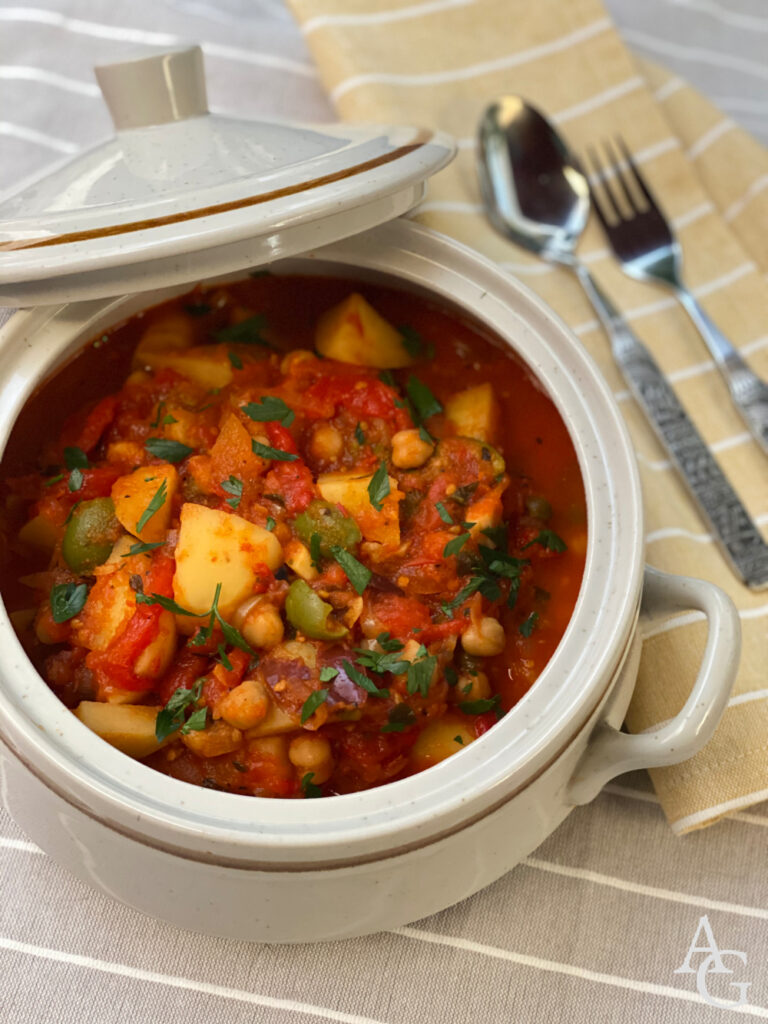
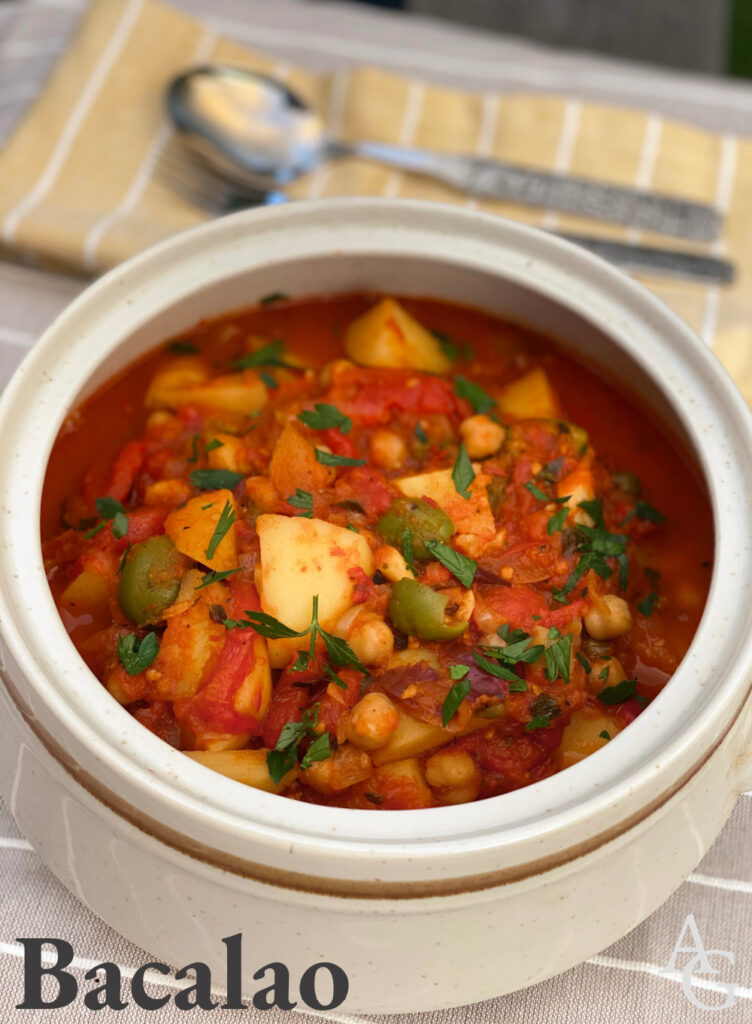
“Klippfisk” is a Norwegian term for salted, dried cod, and comes from the word “klippe”, which is Norwegian for the rocks by the sea, and because the fish was left on the seaside rocks to dry. Klippfisk is a newer phenomenon, probably around 300 years old.
Other methods are used for drying the fish today, but it’s a common theory that the best klippfisk is the one that is left to dry out in the sun.
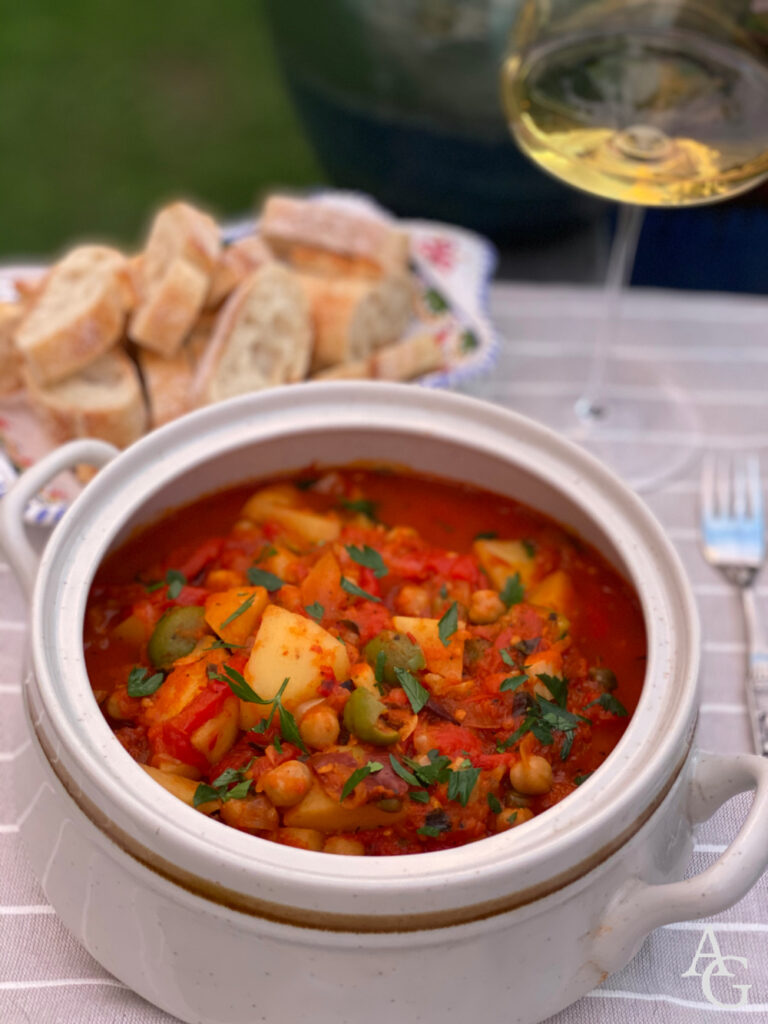
It was the Spaniards, more notably those from the Basque region, who invented klippfisk while fishing for cod in the seas of Newfoundland, Canada, and other international coastlines. The Spanish were fishermen, much like the Norwegians, and while the Norwegians would eat dried fish, the Spanish were fortunate to have great access to salt and consequently started to add salt to the fish to preserve it.
It was a Dutchman, however, who started klippfisk production in Norway, not a Spaniard. Jappe Ippe was his name, and he saw a great opportunity to sell klippfisk along the windy coast of north-western Norway. Cold, windy conditions are necessary for the production and drying of klippfisk, and Norway had plenty of that. He bought several farms for this purpose, but perhaps went too big, too soon.
After 10 years, the Dutch banks would no longer lend him any more money because the war had ended in Holland and they needed the funds at home, and Jappe Ippe was forced to shut down. Although not successful in realizing his big business plan, a seed was planted, and the Scottish followed suit and ran the klippfisk industry through the 18th century.
Another interesting fact I found through researching, was that foreigners installed a law preventing the Norwegians from gaining the knowledge of how to produce klippfisk. They wanted to keep the monopoly on this commodity and as a result, they instituted long jail times, even the death penalty, for people who broke this law.
Finally, in the 19th century, the Norwegians took over the klippfisk production and many families took on side jobs drying fish for larger producers worldwide. With the men being out at sea, this often became a job for the women. The fish was rinsed in the sea after drying, and with the women lacking the right shoe gear to stand in the water, they regularly were barefoot – a cold experience in the middle of winter!! The money earned from this work was thus handled by the women, who would decide how to spend this extra income.
Originally, Kristiansund was the leading city for klippfisk commerce, but later, Ålesund in my home region of Sunmøre became the capital of klippfisk as the fish gradually became depleted further north.
Ålesund is where the traditional drying of the fish on the rocks was replaced with electrical drying indoors. This was also more efficient than the traditional drying on the rocks method practiced in Kristiansund, a town that struggled financially and where businesses had trouble getting financing to expand and modernize.
Having indoor locations for drying, the fishermen in Ålesund were also not dependent on the weather, and all in all, became more competitive in the end. Nevertheless, Kristiansund is still regarded as the ‘klippfisk’ town in Norway today.
Now with all this said and history explained, let me make one thing clear: Personally I think a better, more sustainable (and flavorful!) way to make bacalao, is to substitute salt cod for hearts of palm and chickpeas.
Yes, it might sound strange, but when you think of it, it’s the spices, potatoes, and roast peppers that really make this dish so tasty and unique, and it’s always what I looked forward to when my mom made it for us growing up.
With our oceans getting depleted in just a decade or two if we don’t start thinking of other things to eat, I think it’s a great idea to open our minds and hearts to new ways of cooking.
I promise your enjoyment won’t suffer!
So with this blog post, I’m giving you the ultimate bacalao: with all the familiar flavors, added nutrient-rich ingredients (chickpeas are rich in fiber, fish have none) that are less costly for both your wallet and the environment—and I really promise you won’t miss the fish.
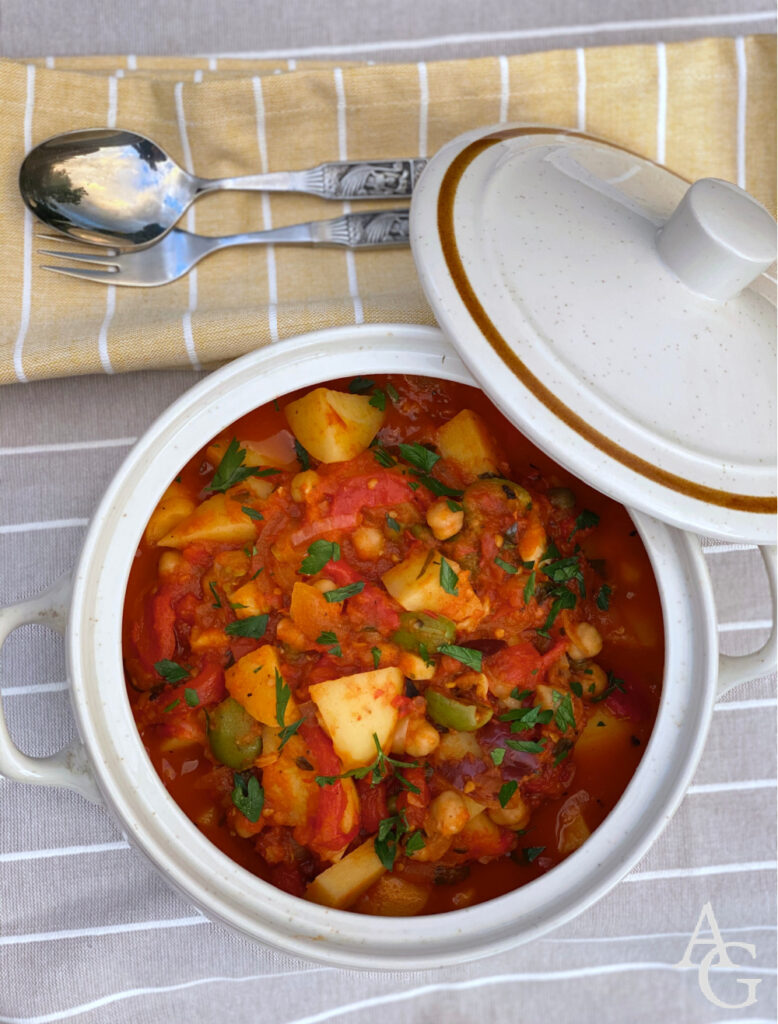
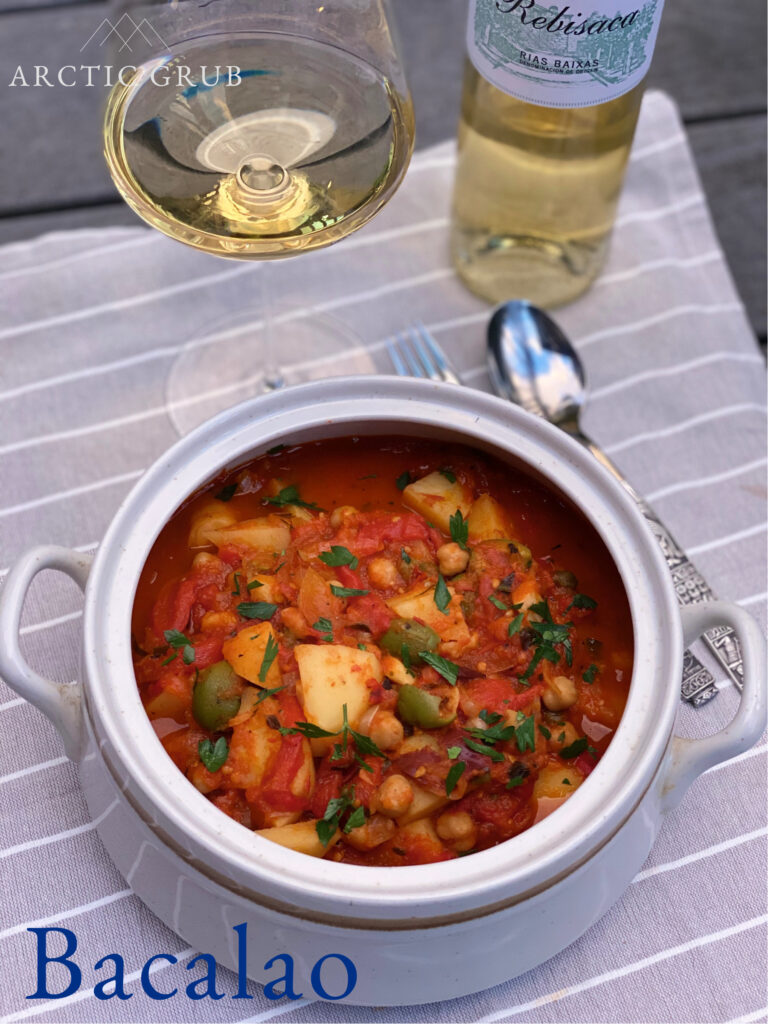
NORVEGAN BACALAO
5 large beefsteak tomatoes (approx 4 lbs or 2 kilos), halved or 2 x 25 oz cans fire-roasted canned tomatoes
2-3 sprigs of fresh thyme and oregano
8 garlic cloves, smashed, divided
3 medium red bell peppers, roasted and sliced thin or 1 large store-bought jar of roasted peppers (pimientos), sliced thin
1 large sweet onion, halved and thinly sliced
2 red chili peppers, chopped with seeds
4 large potatoes (roughly 2 lbs/1 kg), peeled and cubed
2 tsp smoked paprika
1 bay leaf
¼ cup (70 ml) sherry vinegar or dry sherry
1 x 14.5 oz can organic chickpeas
1 x 14.5 oz can hearts of palm, drained and cut into 1-inch pieces
1 tbsp capers
1 cup green or black olives, pitted and halved
2 banana peppers (or pepperoni), pickled
Couple of handfuls of fresh parsley, chopped
Extra virgin olive oil for cooking and roasting tomatoes
If you are making your own tomato sauce, start by placing the halved tomatoes on a sheet tray fitted with a rack, sprinkle with salt, pepper, and place 2 of your smashed garlic cloves and the sprigs of fresh thyme and oregano on the cut side.
Drizzle with a little olive oil then place the tomatoes cut side down in the oven. Bake at 350° for about 30 minutes until the skins are easy to remove (depends on the strength of your oven). Alternatively, you can put them under the broiler for 4-5 minutes until the skins are black, and leave the peppers in the oven for a few more minutes.
Place the tomatoes in a blender, and buzz a few times until you have a chunky sauce, and set aside.
If you’re roasting your own red bell peppers do that next – either over a live gas flame until charred on all sides or in the oven at 400° for about 40 minutes, turning them over halfway.
Place the peppers in a bowl and cover with plastic wrap until they cool down, then remove the skins and clean them of seeds/membranes and slice thinly, then set aside.
Place a large, heavy-bottomed large pot over medium, heat, add a drizzle of olive oil and throw in the sliced onions with a pinch of kosher or sea salt. Sweat the onions for 3-4 minutes, before adding in 6 of the garlic cloves and the red chili peppers and saute for another 1-2 minutes.
Add in the cubed potatoes and the tomato sauce or canned tomatoes with the smoked paprika, bay leaf, sherry or sherry vinegar, and a couple of pinches of kosher salt. Let simmer on medium for about 10-15 minutes, then add in the chickpeas, roasted sliced peppers, hearts of palm, capers and black olives and simmer for another 15 minutes.
Finally add in the banana peppers and chopped fresh parsley, taste, and season with additional salt and simmer for another 10-15 minutes, the final cooking time should ideally be around 45 minutes to 1 hour.
Taste for additional seasoning (salt, smoked paprika, sherry vinegar).
Garnish the bowls of bacalao with extra fresh parsley and serve with a good chunk of bread and a glass of your favorite red or white wine (my suggestions are listed below).
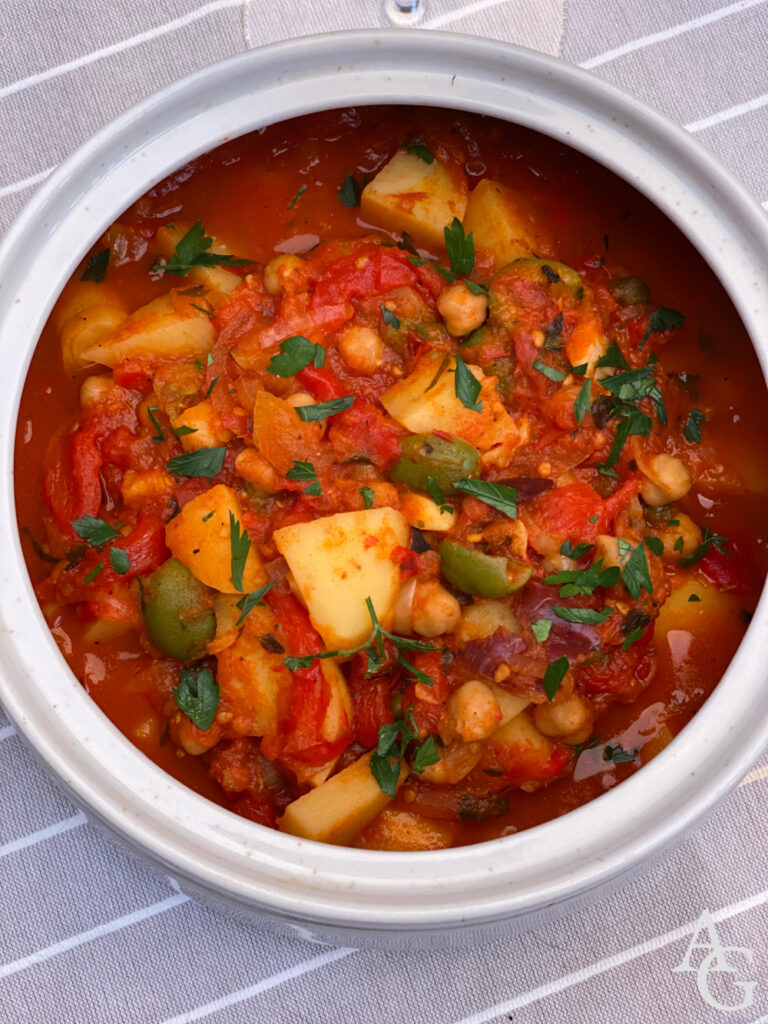
WINE PAIRING SUGGESTION
2016 Do Ferreiro Ribasaca (Spanish white)
2016 Querciabella Mongrana (Italian red)
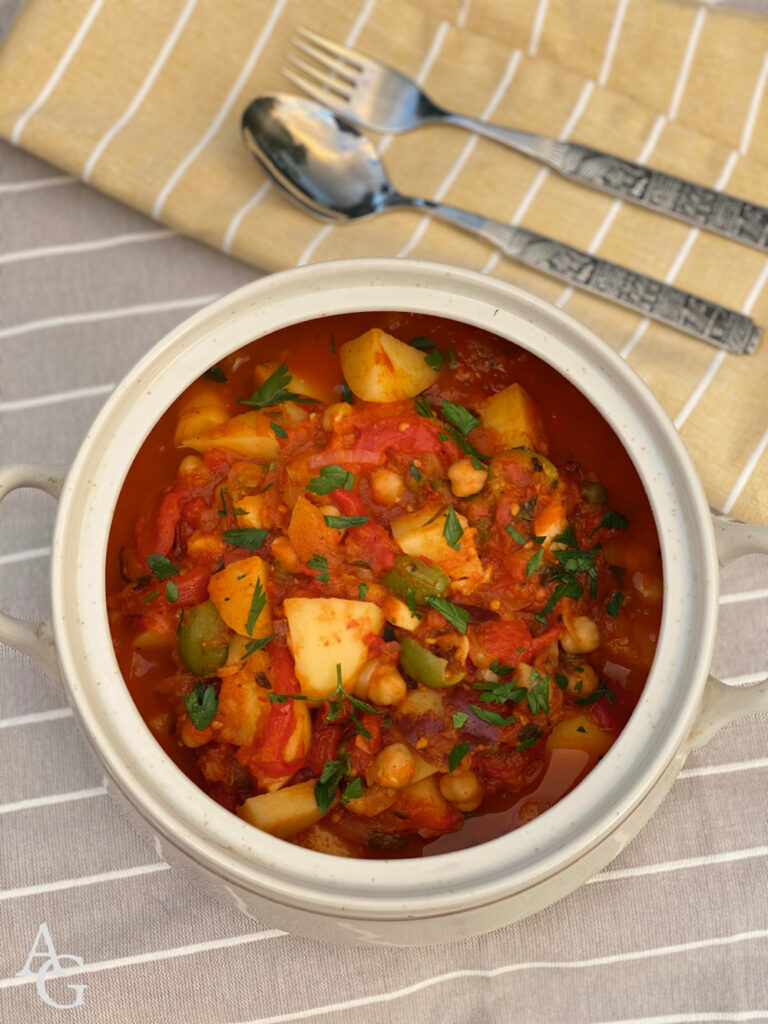
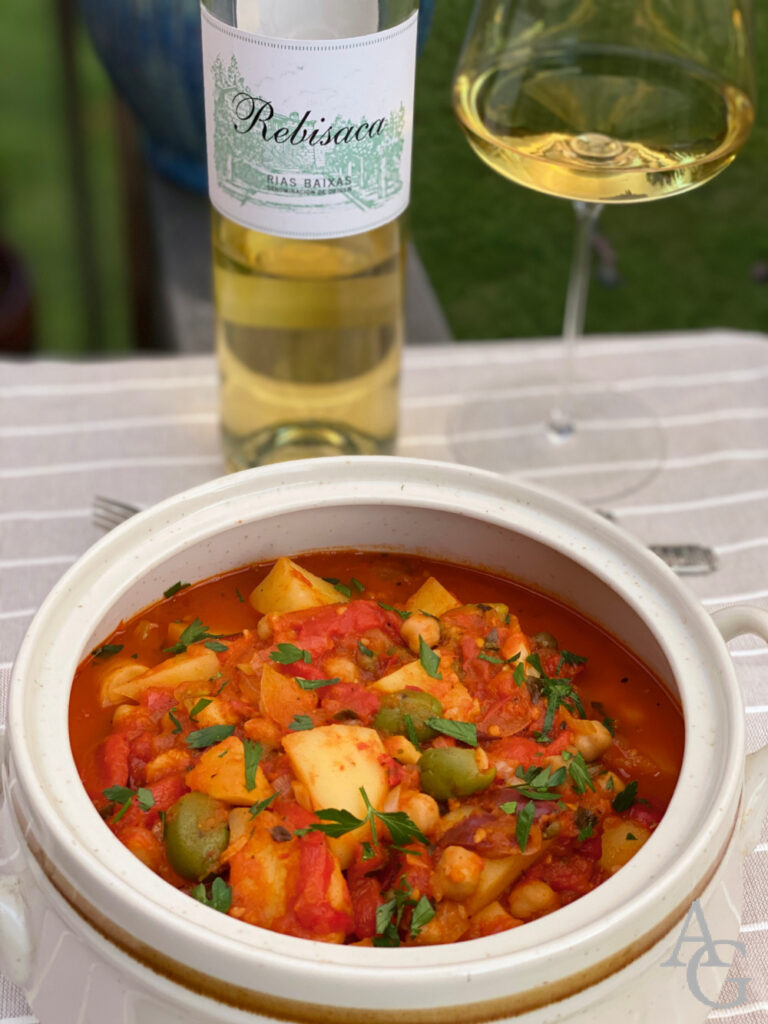
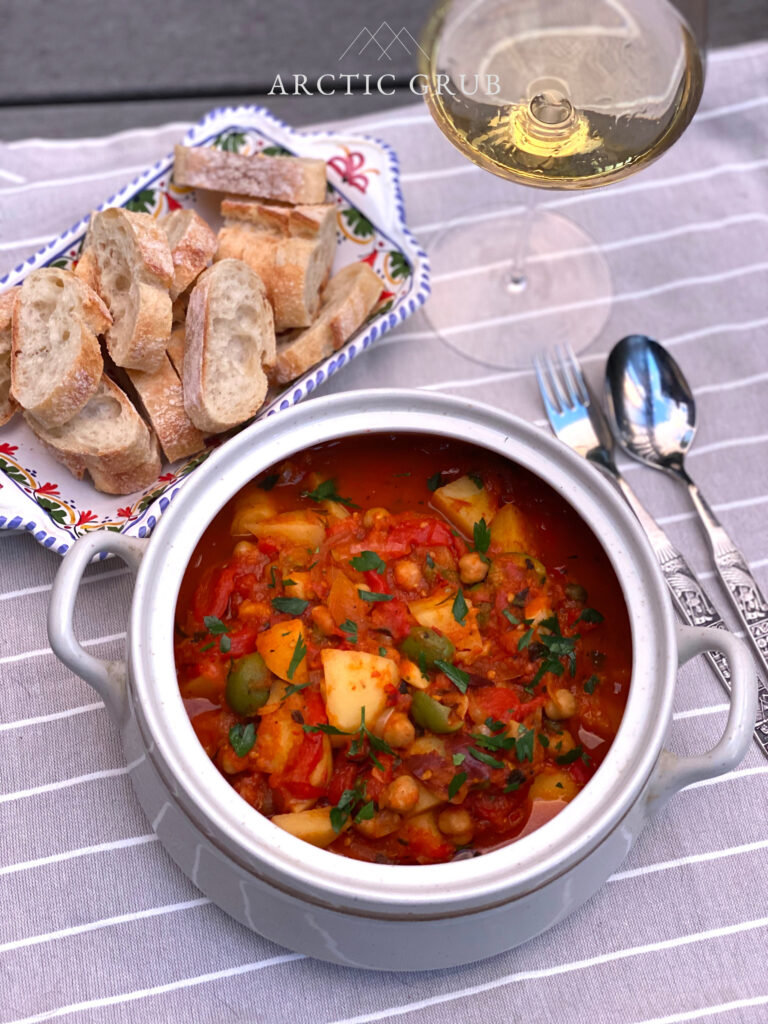
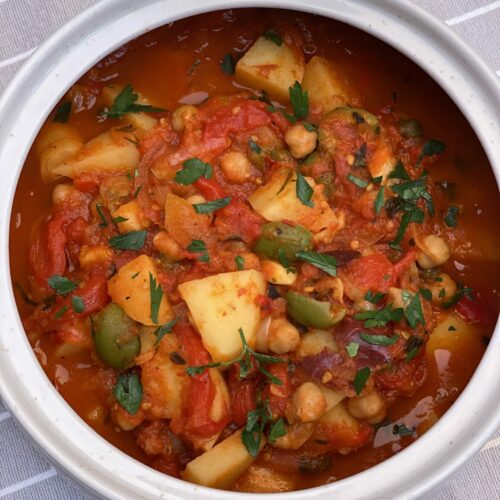
Ingredients
- 5 large beefsteak tomatoes approx 4 lbs or 2 kilos, halved or 2 x 25 oz cans fire-roasted canned tomatoes
- 2-3 sprigs of fresh thyme and oregano
- 8 garlic cloves smashed, divided
- 3 medium red bell peppers roasted and sliced thin or 1 large store-bought jar of roasted peppers (pimientos), sliced thin
- 1 large sweet onion halved and thinly sliced
- 2 red chili peppers chopped with seeds
- 4 large potatoes roughly 2 lbs/1 kg, peeled and cubed
- 2 tsp smoked paprika
- 1 bay leaf
- ¼ cup 70 ml sherry vinegar or dry sherry
- 1 x 14.5 oz can organic chickpeas
- 1 x 14.5 oz can hearts of palm drained and cut into 1-inch pieces
- 1 tbsp capers
- 1 cup green or black olives pitted and halved
- 2 banana peppers or pepperoni, pickled
- Couple of handfuls of fresh parsley chopped
- Extra virgin olive oil for cooking and roasting tomatoes
Instructions
- If you are making your own tomato sauce, start by placing the halved tomatoes on a sheet tray fitted with a rack, sprinkle with salt, pepper, and place 2 of your smashed garlic cloves and the sprigs of fresh thyme and oregano on the cut side.
- Drizzle with a little olive oil then place the tomatoes cut side down in the oven. Bake at 350° for about 30 minutes until the skins are easy to remove (depends on the strength of your oven). Alternatively, you can put them under the broiler for 4-5 minutes until the skins are black, and leave the peppers in the oven for a few more minutes.
- Place the tomatoes in a blender, and buzz a few times until you have a chunky sauce, and set aside.
- If you’re roasting your own red bell peppers do that next – either over a live gas flame until charred on all sides or in the oven at 400° for about 40 minutes, turning them over halfway.
- Place the peppers in a bowl and cover with plastic wrap until they cool down, then remove the skins and clean them of seeds/membranes and slice thinly, then set aside.
- Place a large, heavy-bottomed large pot over medium, heat, add a drizzle of olive oil and throw in the sliced onions with a pinch of kosher or sea salt. Sweat the onions for 3-4 minutes, before adding in 6 of the garlic cloves and the red chili peppers and saute for another 1-2 minutes.
- Add in the cubed potatoes and the tomato sauce or canned tomatoes with the smoked paprika, bay leaf, sherry or sherry vinegar, and a couple of pinches of kosher salt. Let simmer on medium for about 10-15 minutes, then add in the chickpeas, sliced roasted peppers, hearts of palm, capers and black olives and simmer for another 15 minutes.
- Finally add in the banana peppers and chopped fresh parsley, taste, and season with additional salt and simmer for another 10-15 minutes, the final cooking time should ideally be around 45 minutes to 1 hour.
- Taste for additional seasoning (salt, smoked paprika, sherry vinegar).
- Garnish the bowls of bacalao with extra fresh parsley and serve with a good chunk of bread and a glass of your favorite red or white wine (my suggestions are listed below).
Notes
2016 Do Ferreiro Ribasaca (Spanish white)
2016 Querciabella Mongrana (Italian red)








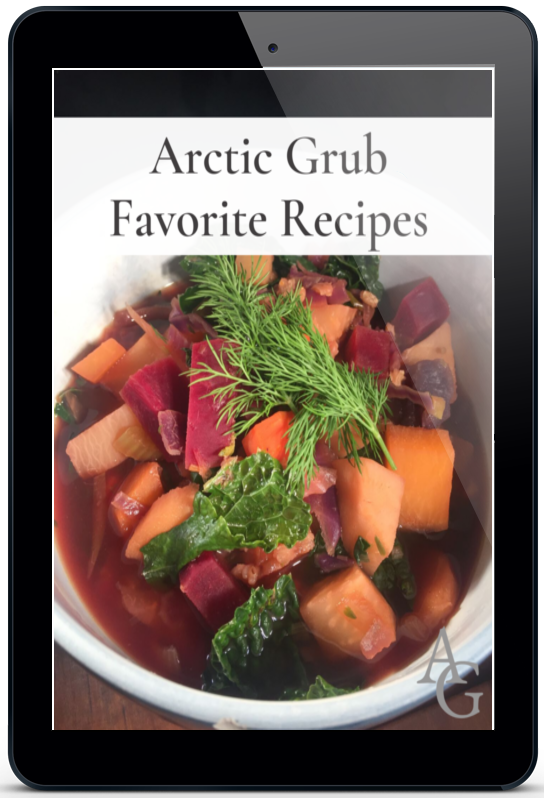
Lovely piece of Norge history thank you
Hi Jeanmario, thank you so much for taking the time to read and to comment, happy you enjoyed the post! – Sunny
Hi there that’s beautiful.
Can you help me understand the connection with Portugal? Apparently even today Portugal fish comes from uo there.
Thank you!
Hi Vlasta, thanks for your comment. Did you read the blog post? I explain it there 🙂
I bought all the ingredients and am making tomorrow, but I’m a bit confused about “if you’re making tomato sauce”. If you’re using fire roasted tomatoes, do you not need the thyme, oregano, and 2 of the garlic cloves? Or will it be nice to add to the pot with the canned fire roasted?
Hi Andrea! glad to hear you are making this tomorrow! I would add the thyme, oregano and garlic to the fire-roasted tomatoes- it just adds more depth to the sauce, (I’m referring to the can of tomatoes here) but add any aromatics you have! 🙂
It’s all prepped and ready and I had already added them to the tomato preparation bowl, 😂. I do see there’s no instructions when to add the red peppers, so I’ll add them with the chick pease etc. I will let you know!
Adding the roast peppers with the chickpeas will work just fine- looking forward to hearing what you think! 🙂
Lovely recipe and looks like the bacalao I am used to eating but, if this is a vegan bacalao without the fish, why would it be called bacalao? Though this looks very tasty, bacalao would be the star of the show since it has that deep salted fish flavor and without it, it would just be stewed vegetables. I’m sorry if I missed something.
Thanks for your comment, and I beg to differ with your view of the dish 🙂 Bacalao is not just about the salted fish, it’s the spices, the tomato sauce and all the other ingredients too. My page is for those who want to re-create dishes they grew up with or used to it, but without the animal ingredient. Hence, I call it bacalo to reference that and to give options for alternatives.
BUT, if we wish to make it with fish, what quantity of bacalao should we use?
Hi John- this is a vegan blog so I don’t provide those directions… sorry! 🙂
It was at the end of the 18th century that the industry (klippfisk) started to grow. Three men, Kåsbøl, Lossius and Knudtzon started the klippfisk trade, and the managed to out-do other producers, because they (Knudtzon the III especially, who was called “Keiseren av Kristiansund”) managed to invent a better way of preserving the fish so it tasted better than that of their copetitors. Knudtzon III had his own fleet of 14 full-masted ships to transport the “merchandise” to all corners of the world. He also built railfoad tracks into Brazil, and (?) Spain, in order to have the clipfish transported inland, where the catholics needed the fish for their Friday meals.
Hi Annie! Thanks for reading my article! And yes, that info is in line with what my blog post – although trade started as early as the 17th century it was in the 18th century it seriously began taking off. Fascinating history for sure and thanks again for sharing!